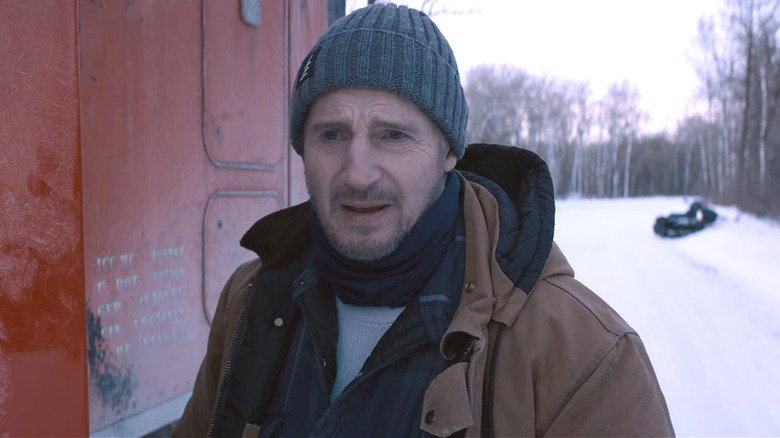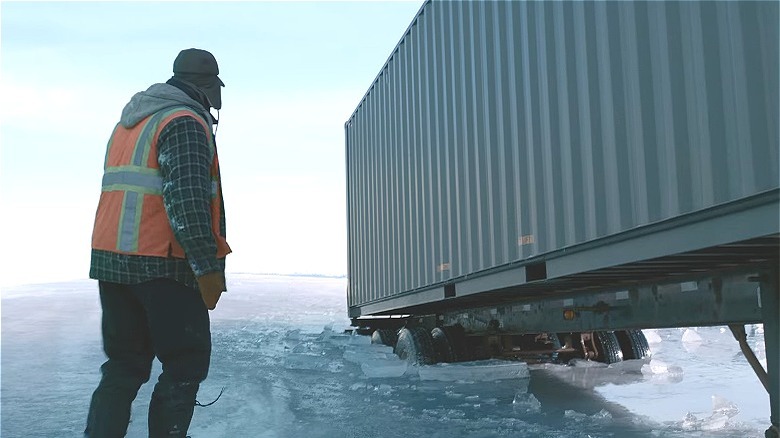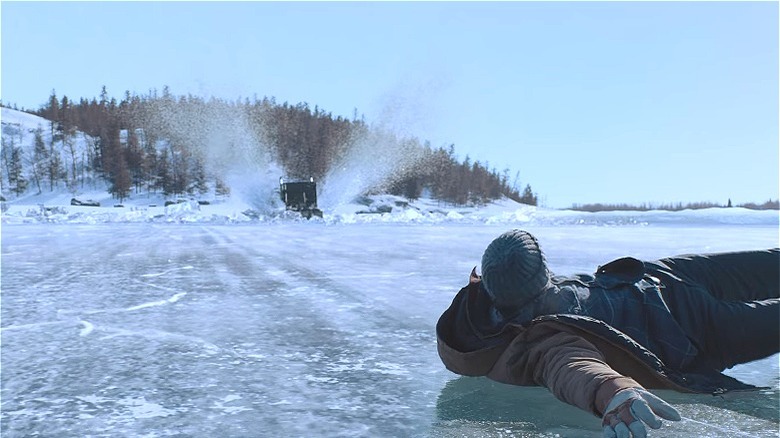Real-Life Ice Road Truckers Break Down Netflix's The Ice Road's Accuracy
Some jobs can be rather cushy. Whether these tasks can be completed at home in the comfort of pajamas, or perhaps offer a ton of perks and a relatively easy workload, some professions have a fairly relaxed experience during their daily nine-to-five grind. Of course, there are some jobs that are on the complete opposite end of this spectrum, and these can see people working in far-off and remote locations engaging in intense physical labor, or perhaps these individuals are surrounded by danger due to the nature of their careers. Ice road trucking probably meets all of these requirements, and those that engage in this job are usually hardy and rugged types of people who don't mind a fair amount of adventure in their paycheck.
The subject of ice road trucking has been the basis for movies and documentaries, like the surprisingly named "Ice Road Truckers." Joking aside, the profession itself is exceptionally dangerous in real life, and according to Logity Dispatch, truckers who specialize in arctic conditions can expect to deal with subzero temperatures, intense weather conditions, and avalanches. Even simply stopping can prove to be fatal since the trucks themselves can weigh up to 60,000 pounds –- not exactly something one would want to give a chance to sink into the snow and ice. Besides the real-life dangers of ice road trucking, this dangerous profession is also featured in Netflix's action-packed film "The Ice Road." But how realistic is this film in the eyes of real-life professionals?
Netflix's The Ice Road adds explosions and schemes to ice road trucking
Checking out the trailer for "The Ice Road" over on YouTube, one can see Liam Neeson, Laurence Fishburne, Amber Midthunder, and Marcus Thomas among majestic and snow-covered landscapes. However, the serenity of these early scenes is shattered when a group of miners becomes trapped, and Neeson's character is tapped to run a piece of equipment over 300 miles of ice road in order to save them. Since "The Ice Road" is an action film, this dangerously simple, yet time-sensitive task, is not only fraught with the normal issues of ice road trucking, but sabotage, explosions, and hostile forces as well.
Speaking with Entertainment Weekly, Neeson was asked if he did any research into his role, and he replied, "I did speak to some truckers, and I drove on the ice. These trucks are like small New York apartments, and they're very, very sensitive." The veteran actor also detailed how he learned about the risks these real-life truckers go through. "In my research, I did find that some of these drivers die on the ice because if they go past a certain speed, it builds up a water wave underneath the ice that when it hits the shore it reverberates back and breaks the ice," Neeson said. "If you're speeding along at say 60 mph, suddenly you're hitting this ice and down you go."
So how realistic is The Ice Road?
In an interview for Netflix, real-life ice road truckers Todd Dewey and Lisa Kelly — who also appear on the show of the same name — broke down several of the scenes in "The Ice Road" and explained how plausible these events are, or if actual truckers have to deal with them. Kelly started the conversation by saying that some actual ice roads look just like the one presented in the movie, while Dewey brought up a scene that mentions that ice road trucking after April is a lethal affair, which is 100% true on account of the ice thawing.
The two then mentioned the same aspect of ice road trucking that Liam Neeson had brought up, and that is the pressure waves created by driving across the ice. Kelly and Dewey both explained that if one moves too slow, they risk sinking into the ice, and if they move too fast, they get the previously mentioned pressure wave. Perhaps the only real issue these two professionals have with the movie is that during one of the convoy scenes, the trucks are entirely too close, which Dewey said is exceptionally dangerous, and even when trucks do break down and are forced to be towed, the tow lines are usually 700 feet.
This means that "The Ice Road" is actually fairly accurate when it comes to some of the dangers real ice road truckers have to deal with. In real life, there's probably far less corporate sabotage and explosions, but that doesn't make the ice any safer to traverse.


